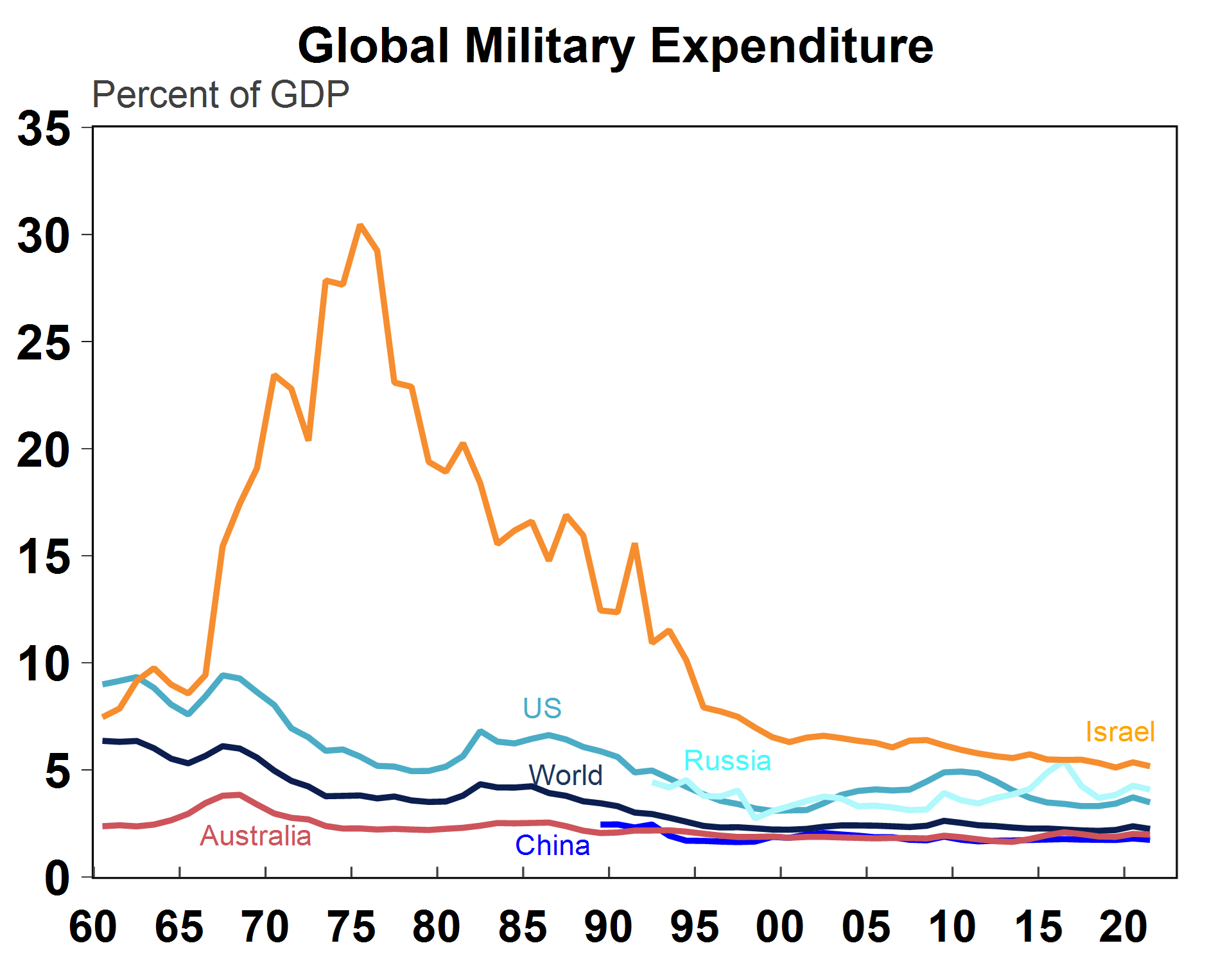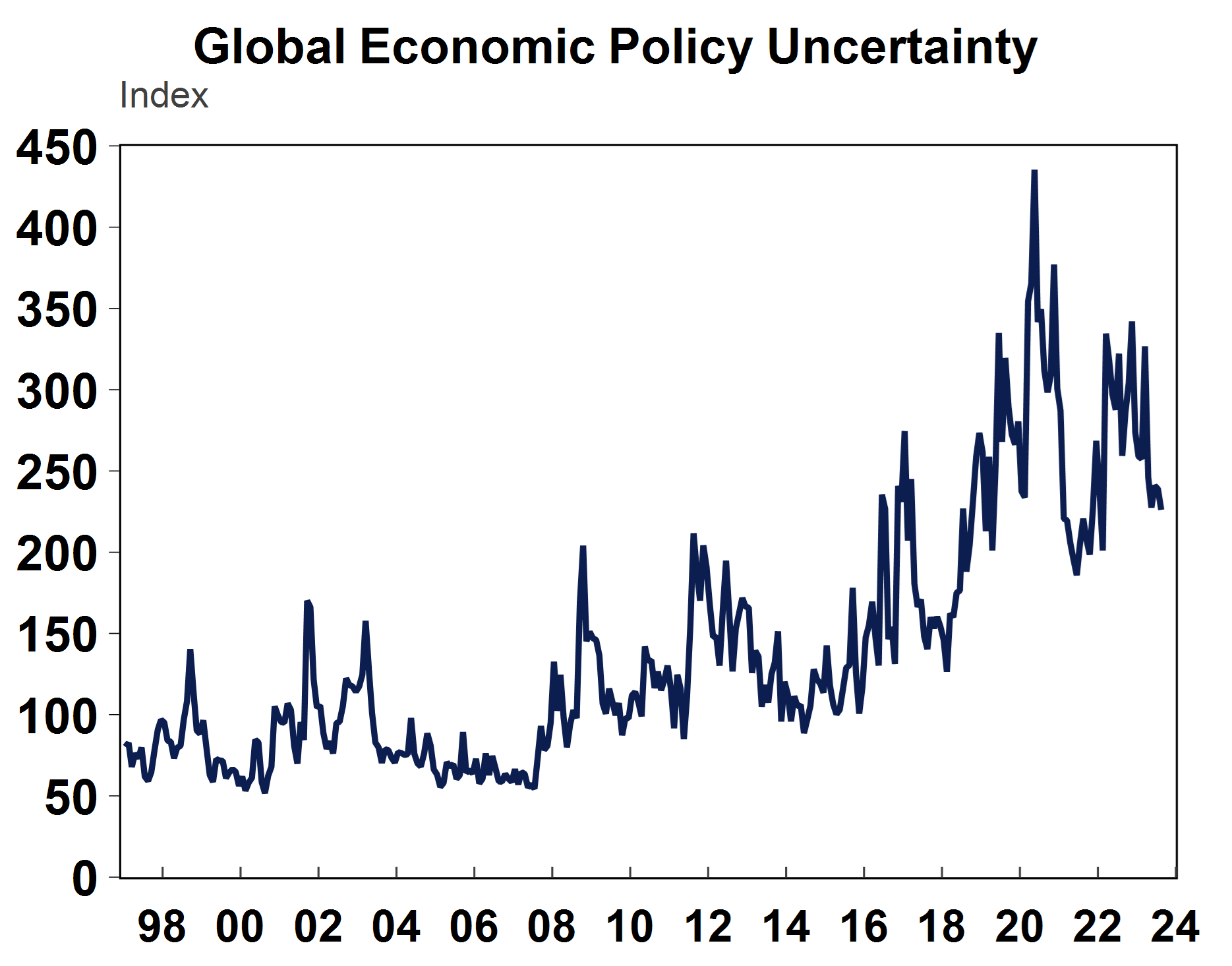Key points
- The last few years have been associated with many geopolitical crises causing investor uncertainty and volatility in financial markets. Geopolitical events can directly impact economic growth through consumer and business confidence flowing through into spending and investment decisions and commodity prices through disruptions to supply chains.
- Measuring geopolitical risks is tricky, but there is a Geopolitical Risk Index that counts newspaper articles mentioning specific words around geopolitics. This is a concurrent indicator of geopolitical risks, rather than a leading indicator of potential risks.
- Spikes in the Geopolitical Risk Index have historically been associated with initial moderate falls in sharemarkets. Economic factors are always occurring occur alongside geopolitical events which impact share returns so it’s hard to pinpoint the exact impact of geopolitical risks on markets. And, a year after the event, shares are usually higher which shows that markets eventually recover from the initial shock.
- The difficulty in predicting the exact timing of geopolitical events means that it’s important to have a diversified investment portfolio.
Introduction
The recent horrible events in Israel and Palestine are a reminder that geopolitical events are a constant risk to the global order. While these events may appear to occur out of nowhere, the reality is that tensions are often bubbling under the surface for some time, until a tipping point is reached. This is why predicting precisely when geopolitical events will occur is extremely difficult. Although, outlining potential areas of risk can be useful for thinking about future dangers. Geopolitical events tend to create volatility in financial markets and as a result, investors have become more interested in geopolitical risks over the past few years. We look at the impact of geopolitics on financial markets in this edition of Econosights.
Measuring geopolitical risks
It feels like the world has been moving from one geopolitical event another in recent years between Brexit, European elections and the threat of another exit from the Eurozone, US Presidential elections, US/China trade war, Hong Kong protests, the decline in globalisation, China/Taiwan tensions and the war in Ukraine. Is there a reason for why geopolitics seem to have become more prevalent now? One explanation is that it reflects the gradual increase in inequality leading up to the pandemic across many major advanced economies which led to a move away from centrist government policies in favour of the extreme left and right fringes of the political spectrum. Or perhaps geopolitical risks seem to be more prevalent because we pay more attention to global events now through the easier dissemination of news across the world, with an estimated 85% of the world now holding a smartphone.
One way to measure changes in geopolitical events is through a “Geopolitical Risk Index” which was constructed by Dario Caldara and Matteo Iacoviello based on a tally of newspaper articles since 1900. The chart below shows the changes in the long-term index, with events that caused the largest spikes in the index highlighted in the chart. Newspaper articles are searched for words that include citations of war threats, peace threats, military buildups, nuclear threats, terror threats, beginning of war, escalation of war and terror acts. The index should be considered a concurrent indicator of rising or falling geopolitical risks, rather than a leading indicator of when tensions will erupt.

Source: https://www.matteoiacoviello.com/gpr.htm, AMP
The impact of geopolitical risks on economies and markets
There are numerous potential impacts of geopolitics on economies. Direct impacts can occur through a loss to consumer and business confidence in the countries impacted which flows through to spending, investment and GDP growth. In the case of war, the destruction of buildings and infrastructure has a large negative initial hit to growth, but the eventual rebuilding often causes a lift to GDP growth down the track. Countries that trade with affected countries are also impacted through the changes to import and export flows. Commodity prices are often impacted by geopolitical events because of the disruption to supply. Financial markets also respond to geopolitical risks usually via the sharemarket both in directly affected countries but also across the major economies because of the impact to confidence. Currencies of impacted countries can often experience a depreciation in response to events as investor uncertainty rises.
We can use historical spikes in the Geopolitical Risk Index to look at the initial impact of prior geopolitical events on financial markets. The next table looks at the major events that led to the Geopolitical Risk Index spiking to historical extremes and initial market reactions in the US S&P500. This shows that the major geopolitical events are often associated with moderate drawdowns in US shares with the 6 major events highlighted in the table leading to an average of a 10% fall in US shares as an initial market reaction to the event.

Source: https://www.matteoiacoviello.com/gpr.htm, Bloomberg, AMP
However, it’s important to keep in mind that there are economic factors at play that are also influencing returns, alongside geopolitical risks. For example, the period around the Gulf War was associated with a recession in the US and the US/Iraq war in 2003 was occurring right after the US tech crash. The current conflict in Israel has been occurring while US bond yields are reaching their highest levels since 2007 (we wrote about the reasons behind the rise in yields here which are mostly to do with expectations for higher inflation, stronger economic growth and concern about the US budget deficit) which has been a major factor behind the fall in shares. Depending on the nature of the geopolitical event, the impact to sharemarkets could also be short-lived or may take longer to play out. The above table also shows that despite the negative hit to shares initially from these geopolitical events, usually sharemarkets recover with US equity returns a year after the event up by an average of 15% over the 6 events we looked at. For the times when sharemarkets were lower a year after the geopolitical event, this was associated with another economic event (in 2002 post 9/11 was in the middle of the tech crash and in 2023 after the Russia/Ukraine war was the US banking crisis).
The current war in Israel has led to a modest rise in oil prices, up by around $US5 a barrel to $US88 for West Texas Intermediate since the initial Hamas attack on Israel which we recently wrote about here. While Israel itself is not a major producer, the conflict could drag in other major oil producers in the Middle East like Iran (who financially back Hamas and Hezbollah in Lebanon) and account for 2.5% of global oil consumption. The immediate concern is that higher oil prices will lead to a resurgence in inflation and threaten central bank inflation targets, leading to higher interest rates, similar to the break out in commodity prices last year. While higher commodity prices are a threat to inflation, the current economic environment is different to 2022 when interest rates were lower and the hiking cycle just began and household budgets were in a better shape. So, higher oil prices now will only threaten inflation if it gets passed through the supply chain.
Australia has a very small trade relationship with Israel and is only worth 0.1% of exports and 0.2% of imports so the direct impact to the Australian economy from the conflict is low. The majority of the impact to Australia will be via financial market sentiment and commodity prices like oil.
Implications for investors
While it may feel like there are more geopolitical risks than before which risks moving the world into a continuous dysfunctional and fragmented global order (leading to increased volatility for returns) the Geopolitical Risk Index in the decade prior to the pandemic was moving in line with the historical average, rather than trending higher. Global military spending has actually been on a long-term decline (see the chart below) which could also be a sign of simmering global tensions rather than rising tensions, declining from over 6% of GDP in 1960 to its current level of 2.2% of GDP. Although, there is a risk that near-term military spending rises due to the war in Ukraine which has also involved many Western countries.

Source: Macrobond, AMP
The biggest geopolitical risks for the next few years are: the US and China technological rivalry, the race by both to be the dominant world power at a time when China is becoming a larger share of the global economy which is moving the world from a unipolar to a multi-polar, a potential China/Taiwan war, global elections (the US has its Presidential election in 2024 along with Russia and Taiwan) and risks around Iran’s building nuclear capability. Given the difficulty with predicting precise timings of geopolitical events, it’s important to be mindful of some of the major risks on the horizon but timing these events and predicting which scenario will play out will be impossible. The bottom line is that it’s important to have a diversified investment portfolio.
The other (and perhaps more important) source of volatility in markets in recent years has been significant changes to monetary and fiscal policy which is reflected in a rise in Economic Policy Uncertainty (see the chart below) which is derived from newspaper articles sourcing topics around the economy, government legislation, budgets, regulation and economic terms like central banks and interest rates. From here, the outlook for sharemarkets is mixed. The high risk of a recession in the next 6-12 months and the rise in bond yields means that the next few months of sharemarket returns could be rocky and another leg down in shares cannot be ruled out. But, the longer term view on shares remains positive as we expect inflation to decline in 2024 which should allow, central banks to eventually cut interest rates next year which will support returns and corporate earnings.

Source: Macrobond, AMP

Oliver's insights - Trump challenges and constraints
19 November 2024 | Blog Why investors should expect a somewhat rougher ride, but it may not be as bad as feared with Donald Trump's US election victory. Read more
Econosights - strong employment against weak GDP growth
18 November 2024 | Blog The persistent strength in the Australian labour market has occurred against a backdrop of poor GDP growth, which is unusual. We go through this issue in this edition of Econosights. Read more

